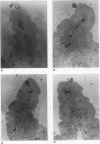Abstract
Flow cytofluorometric analyses of lymphocytes harvested from the mesenteric lymph node (MLN), mucosal epithelium, and lamina propria of C57BL/6 mice demonstrate that expression of alpha/beta or gamma/delta T-cell receptors (TCR) and CD4 or CD8 molecules by T lymphocytes in the intestinal immune system varies depending upon their anatomic location. The MLN contained equivalent numbers of CD4+ and CD8+ T cells, the vast majority of which were alpha/beta TCR positive (alpha/beta TCR+). The lamina propria T cells were predominantly CD4+ and alpha/beta TCR+, while the intestinal intraepithelial lymphocytes consisted of equivalent numbers of alpha/beta and gamma/delta T cells, the majority of which were CD8+. There were no significant changes in these T-cell phenotypic profiles when the mice were antibiotic decontaminated or monoassociated with Escherichia coli. Mice were depleted of CD4+ T cells and/or CD8+ T cells in vivo by intraperitoneal injections of monoclonal antibody GK 1.5 (rat anti-mouse CD4) and/or monoclonal antibody 2.43 (rat anti-mouse CD8). T-cell depletion was confirmed in the MLN, lamina propria, and the intestinal epithelium by flow cytometry. E. coli C25 translocation from the gastrointestinal (GI) tract to the MLN was significantly increased in mice depleted of CD4+ T cells, CD8+ T cells, or both. T-cell-deficient athymic beige/nude mice also exhibited greater levels of E. coli C25 translocation to the MLN than beige/het euthymic littermates. Salmonella typhimurium translocation also was increased following CD4+ and CD8+ T-cell depletion in mice monoassociated with S. typhimurium. Depletion of CD4+ and/or CD8+ T cells also increased the translocation to the MLN of certain indigenous GI flora bacteria. These results confirm that T-cell-mediated immunity is involved in the host defense against bacterial translocation from the GI tract.
Full text
PDF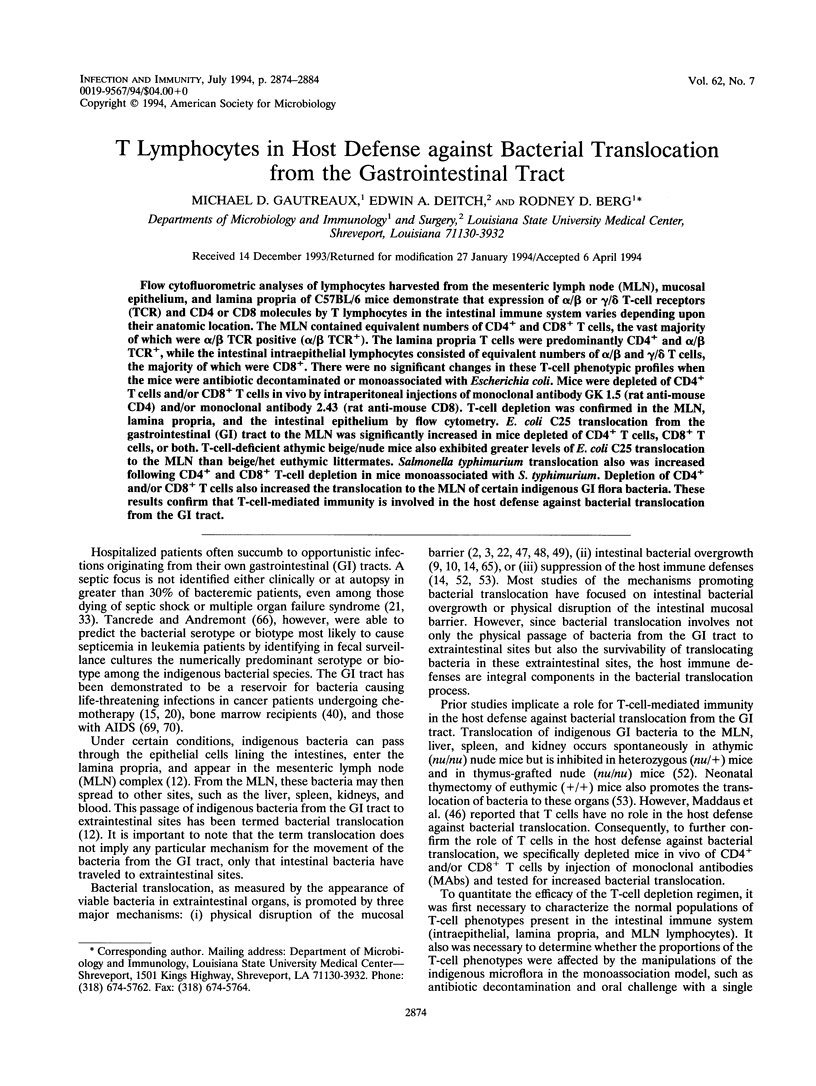
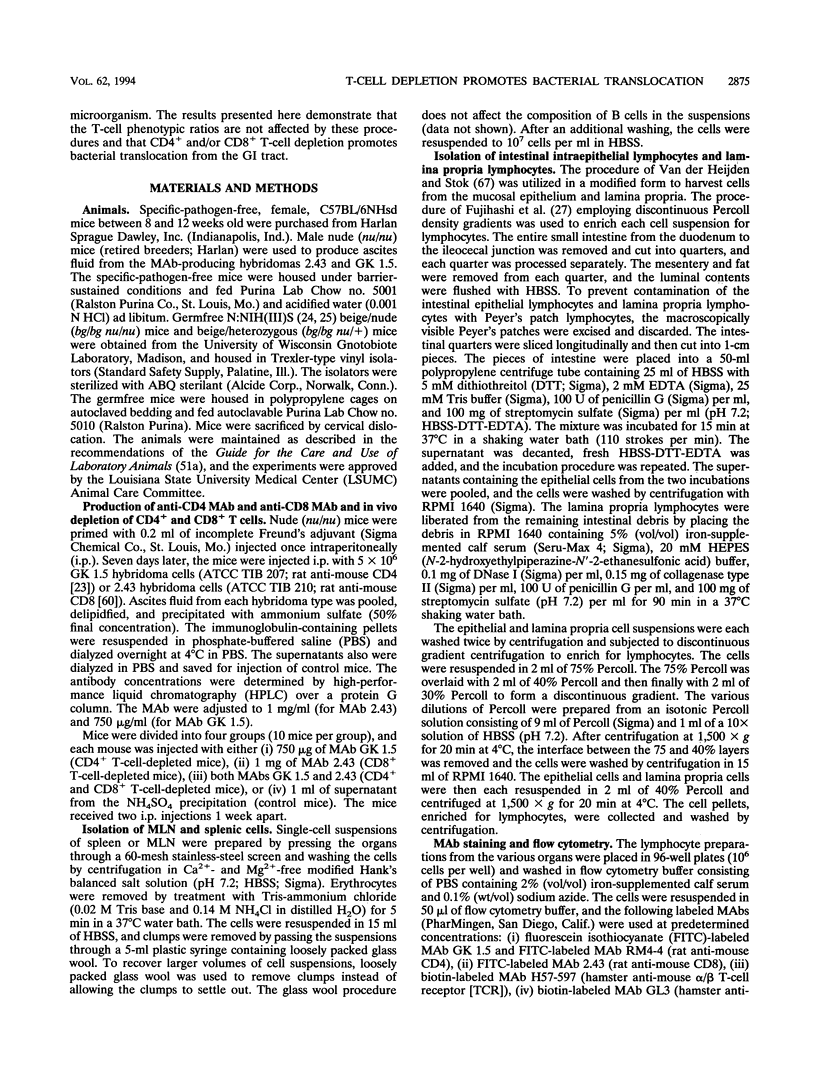
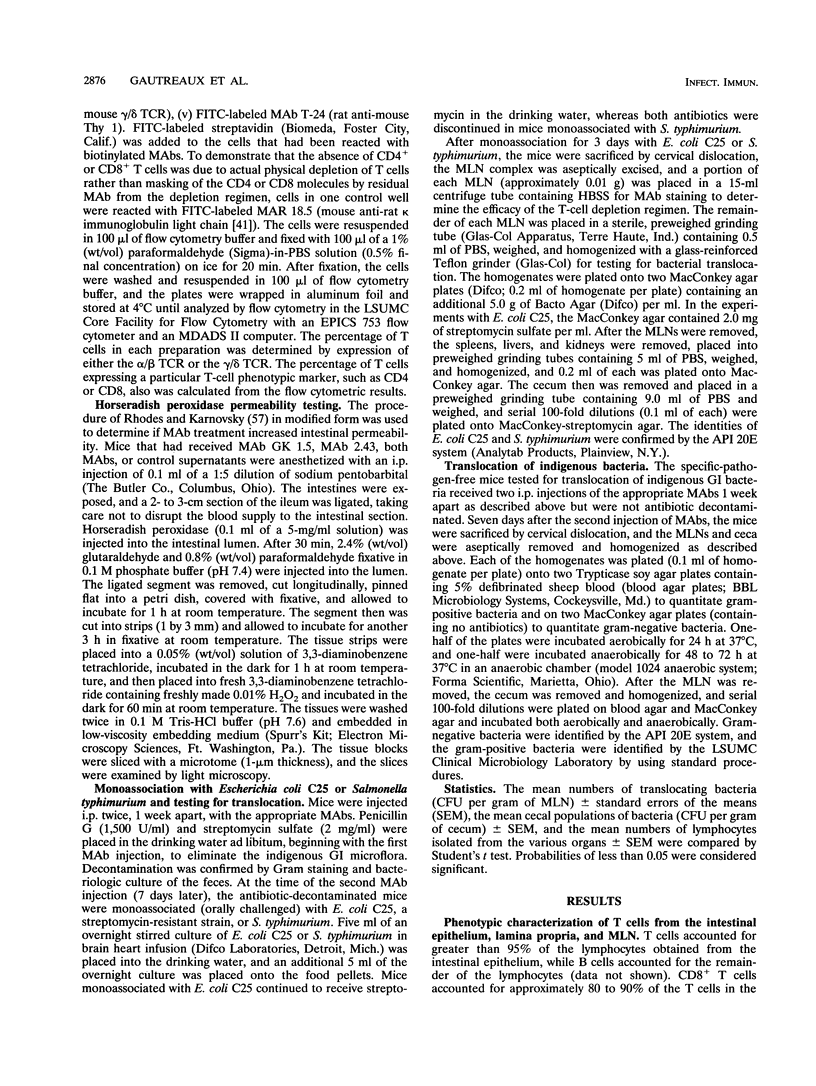
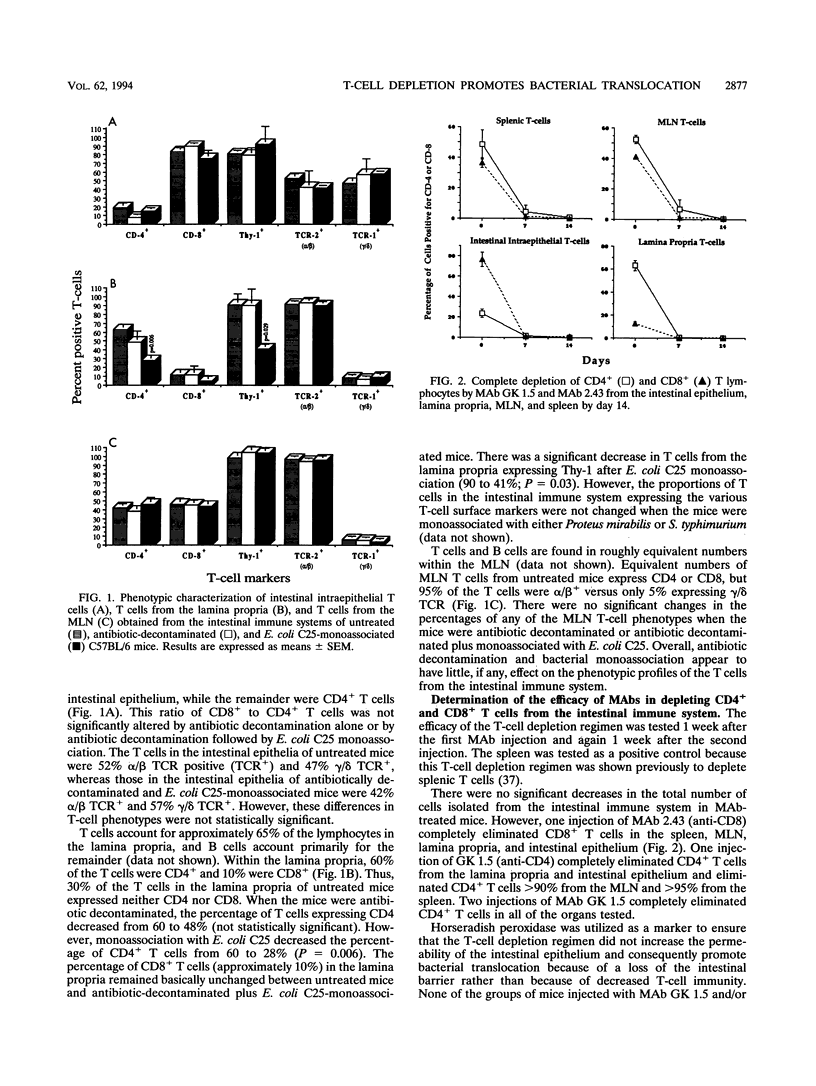
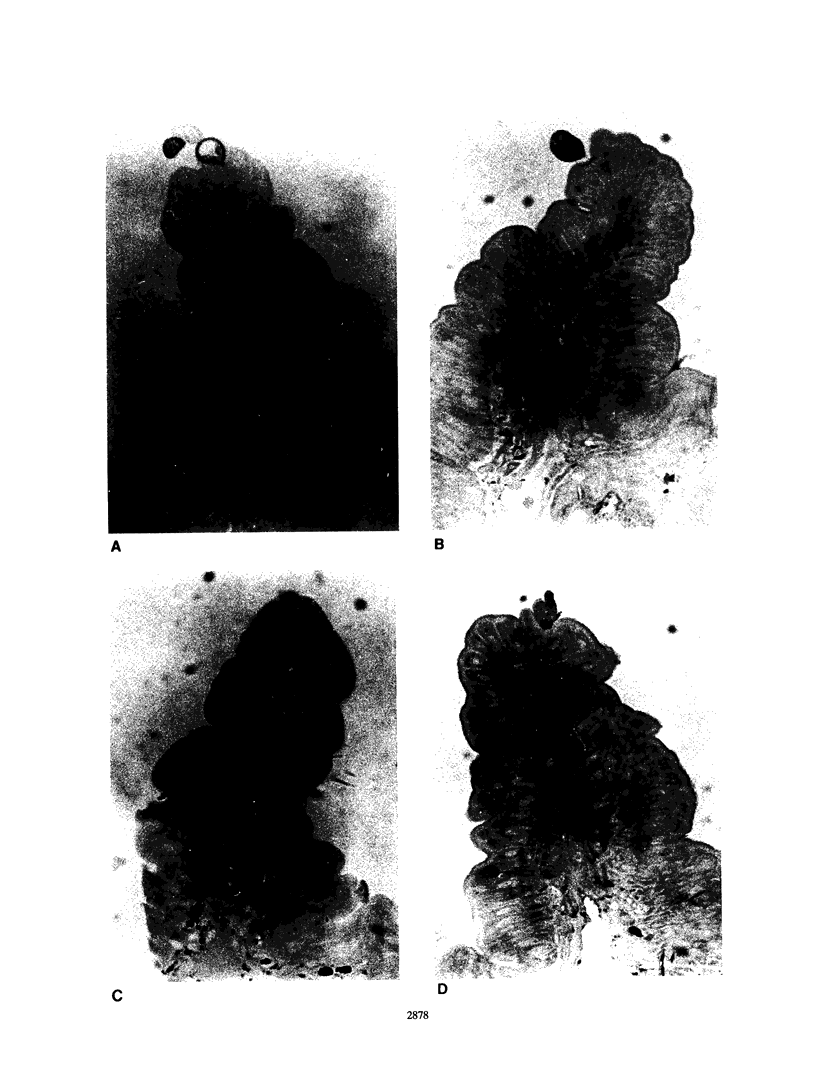
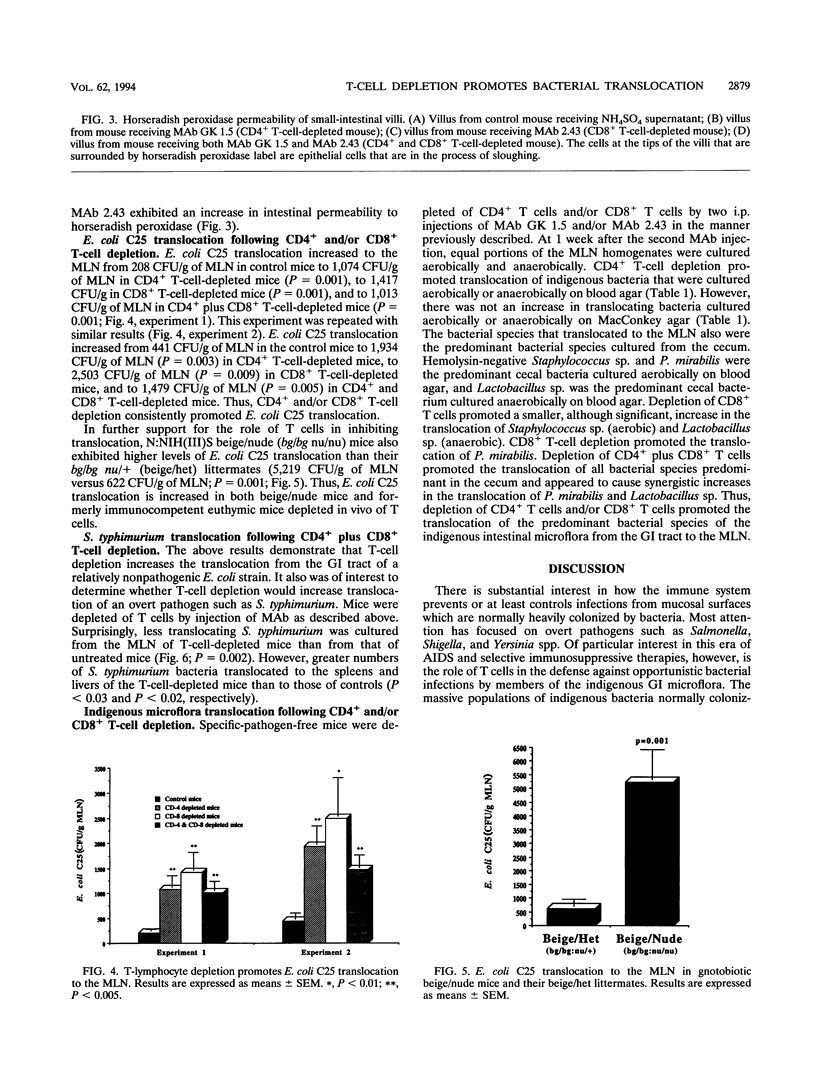
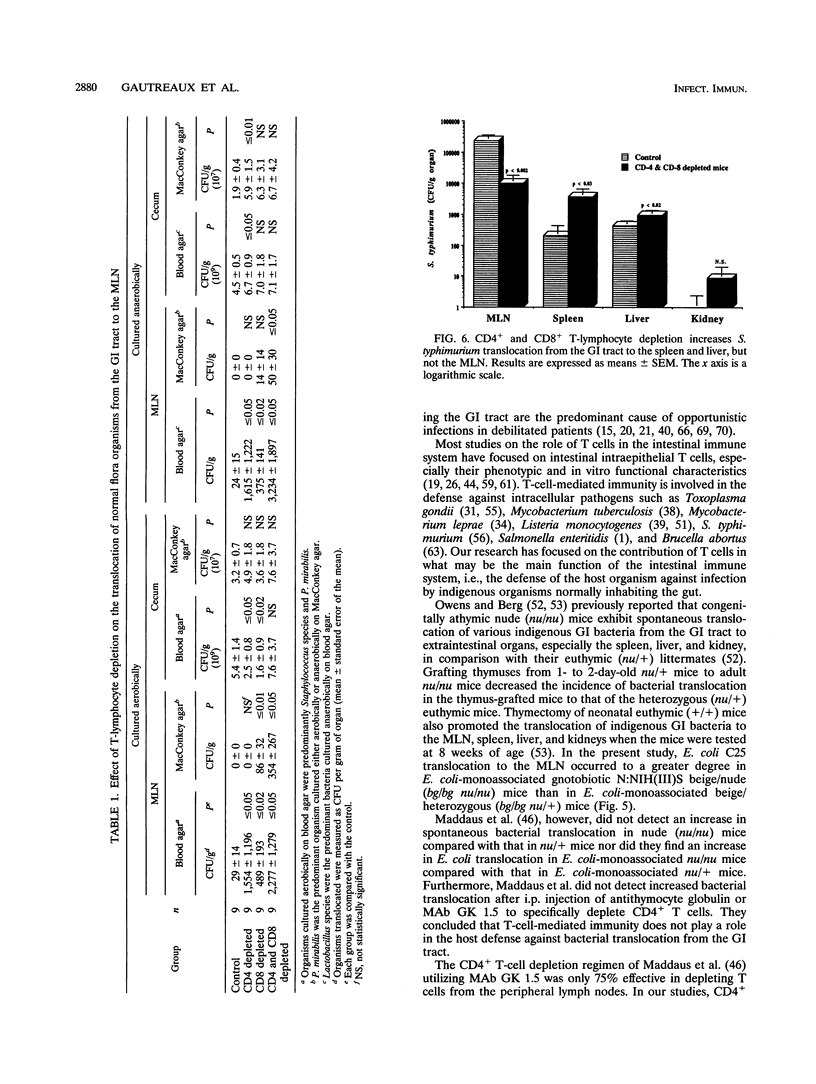
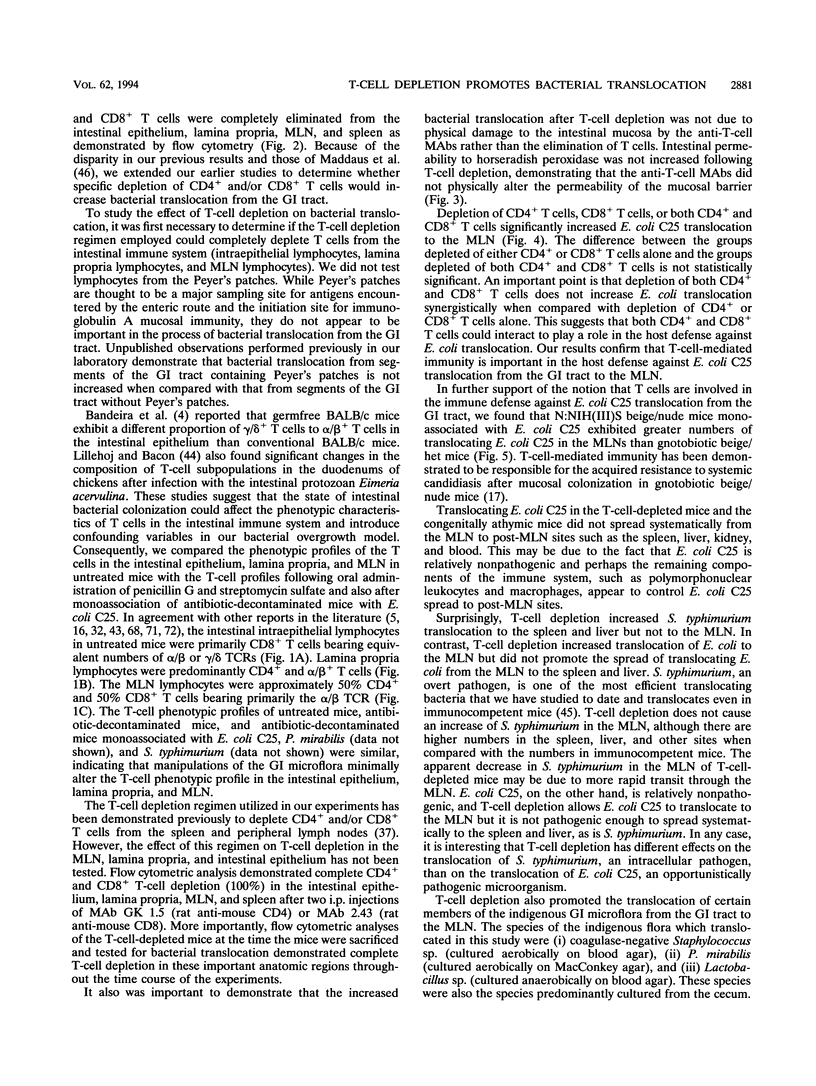
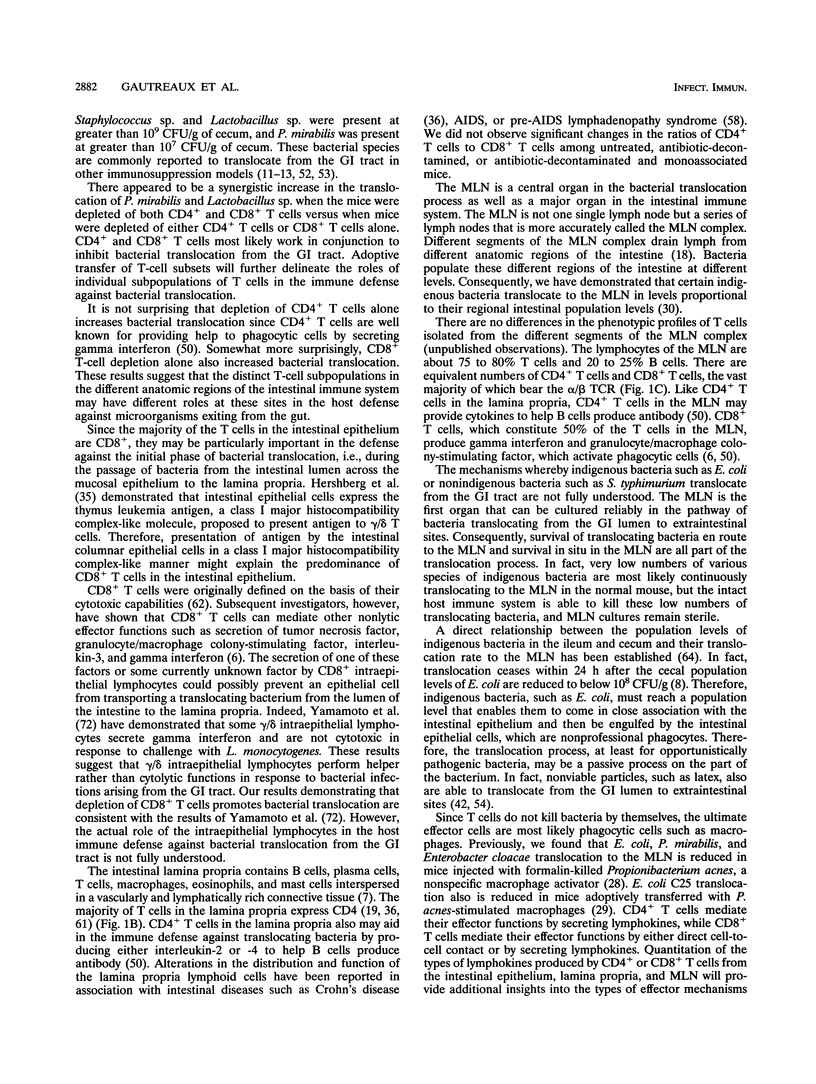


Images in this article
Selected References
These references are in PubMed. This may not be the complete list of references from this article.
- Attridge S. R., Kotlarski I. Local transfer of delayed-type hypersensitivity after Salmonella infection in mice. Infect Immun. 1985 Dec;50(3):807–812. doi: 10.1128/iai.50.3.807-812.1985. [DOI] [PMC free article] [PubMed] [Google Scholar]
- Baker J. W., Deitch E. A., Li M., Berg R. D., Specian R. D. Hemorrhagic shock induces bacterial translocation from the gut. J Trauma. 1988 Jul;28(7):896–906. doi: 10.1097/00005373-198807000-00002. [DOI] [PubMed] [Google Scholar]
- Bandeira A., Mota-Santos T., Itohara S., Degermann S., Heusser C., Tonegawa S., Coutinho A. Localization of gamma/delta T cells to the intestinal epithelium is independent of normal microbial colonization. J Exp Med. 1990 Jul 1;172(1):239–244. doi: 10.1084/jem.172.1.239. [DOI] [PMC free article] [PubMed] [Google Scholar]
- Barrett T. A., Gajewski T. F., Danielpour D., Chang E. B., Beagley K. W., Bluestone J. A. Differential function of intestinal intraepithelial lymphocyte subsets. J Immunol. 1992 Aug 15;149(4):1124–1130. [PubMed] [Google Scholar]
- Barth R. J., Jr, Mulé J. J., Spiess P. J., Rosenberg S. A. Interferon gamma and tumor necrosis factor have a role in tumor regressions mediated by murine CD8+ tumor-infiltrating lymphocytes. J Exp Med. 1991 Mar 1;173(3):647–658. doi: 10.1084/jem.173.3.647. [DOI] [PMC free article] [PubMed] [Google Scholar]
- Bartnik W., ReMine S. G., Chiba M., Thayer W. R., Shorter R. G. Isolation and characterization of colonic intraepithelial and lamina proprial lymphocytes. Gastroenterology. 1980 May;78(5 Pt 1):976–985. [PubMed] [Google Scholar]
- Berg R. D., Garlington A. W. Translocation of certain indigenous bacteria from the gastrointestinal tract to the mesenteric lymph nodes and other organs in a gnotobiotic mouse model. Infect Immun. 1979 Feb;23(2):403–411. doi: 10.1128/iai.23.2.403-411.1979. [DOI] [PMC free article] [PubMed] [Google Scholar]
- Berg R. D. Inhibition of Escherichia coli translocation from the gastrointestinal tract by normal cecal flora in gnotobiotic or antibiotic-decontaminated mice. Infect Immun. 1980 Sep;29(3):1073–1081. doi: 10.1128/iai.29.3.1073-1081.1980. [DOI] [PMC free article] [PubMed] [Google Scholar]
- Berg R. D. Mechanisms confining indigenous bacteria to the gastrointestinal tract. Am J Clin Nutr. 1980 Nov;33(11 Suppl):2472–2484. doi: 10.1093/ajcn/33.11.2472. [DOI] [PubMed] [Google Scholar]
- Berg R. D. Promotion of the translocation of enteric bacteria from the gastrointestinal tracts of mice by oral treatment with penicillin, clindamycin, or metronidazole. Infect Immun. 1981 Sep;33(3):854–861. doi: 10.1128/iai.33.3.854-861.1981. [DOI] [PMC free article] [PubMed] [Google Scholar]
- Berg R. D., Wommack E., Deitch E. A. Immunosuppression and intestinal bacterial overgrowth synergistically promote bacterial translocation. Arch Surg. 1988 Nov;123(11):1359–1364. doi: 10.1001/archsurg.1988.01400350073011. [DOI] [PubMed] [Google Scholar]
- Bodey G. P. Antibiotic prophylaxis in cancer patients: regimens of oral, nonabsorbable antibiotics for prevention of infection during induction of remission. Rev Infect Dis. 1981 Nov-Dec;3 Suppl:S259–S268. [PubMed] [Google Scholar]
- Bonneville M., Janeway C. A., Jr, Ito K., Haser W., Ishida I., Nakanishi N., Tonegawa S. Intestinal intraepithelial lymphocytes are a distinct set of gamma delta T cells. Nature. 1988 Dec 1;336(6198):479–481. doi: 10.1038/336479a0. [DOI] [PubMed] [Google Scholar]
- Cantorna M. T., Balish E. Acquired immunity to systemic candidiasis in immunodeficient mice. J Infect Dis. 1991 Nov;164(5):936–943. doi: 10.1093/infdis/164.5.936. [DOI] [PubMed] [Google Scholar]
- Carter P. B., Collins F. M. The route of enteric infection in normal mice. J Exp Med. 1974 May 1;139(5):1189–1203. doi: 10.1084/jem.139.5.1189. [DOI] [PMC free article] [PubMed] [Google Scholar]
- Cerf-Bensussan N., Schneeberger E. E., Bhan A. K. Immunohistologic and immunoelectron microscopic characterization of the mucosal lymphocytes of human small intestine by the use of monoclonal antibodies. J Immunol. 1983 Jun;130(6):2615–2622. [PubMed] [Google Scholar]
- Cesario T. C., Slater L. M., Armentrout S. A., Thrupp L. D., Tilles J. G. Septicemia in acute leukemia. Med Pediatr Oncol. 1978;5(1):193–203. doi: 10.1002/mpo.2950050127. [DOI] [PubMed] [Google Scholar]
- Deitch E. A. Multiple organ failure. Pathophysiology and potential future therapy. Ann Surg. 1992 Aug;216(2):117–134. doi: 10.1097/00000658-199208000-00002. [DOI] [PMC free article] [PubMed] [Google Scholar]
- Deitch E. A., Winterton J., Berg R. Thermal injury promotes bacterial translocation from the gastrointestinal tract in mice with impaired T-cell-mediated immunity. Arch Surg. 1986 Jan;121(1):97–101. doi: 10.1001/archsurg.1986.01400010111015. [DOI] [PubMed] [Google Scholar]
- Dialynas D. P., Wilde D. B., Marrack P., Pierres A., Wall K. A., Havran W., Otten G., Loken M. R., Pierres M., Kappler J. Characterization of the murine antigenic determinant, designated L3T4a, recognized by monoclonal antibody GK1.5: expression of L3T4a by functional T cell clones appears to correlate primarily with class II MHC antigen-reactivity. Immunol Rev. 1983;74:29–56. doi: 10.1111/j.1600-065x.1983.tb01083.x. [DOI] [PubMed] [Google Scholar]
- Fodstad O., Hansen C. T., Cannon G. B., Boyd M. R. Immune characteristics of the beige-nude mouse. A model for studying immune surveillance. Scand J Immunol. 1984 Sep;20(3):267–272. doi: 10.1111/j.1365-3083.1984.tb01002.x. [DOI] [PubMed] [Google Scholar]
- Fodstad O., Hansen C. T., Cannon G. B., Statham C. N., Lichtenstein G. R., Boyd M. R. Lack of correlation between natural killer activity and tumor growth control in nude mice with different immune defects. Cancer Res. 1984 Oct;44(10):4403–4408. [PubMed] [Google Scholar]
- Fujihashi K., Taguchi T., Aicher W. K., McGhee J. R., Bluestone J. A., Eldridge J. H., Kiyono H. Immunoregulatory functions for murine intraepithelial lymphocytes: gamma/delta T cell receptor-positive (TCR+) T cells abrogate oral tolerance, while alpha/beta TCR+ T cells provide B cell help. J Exp Med. 1992 Mar 1;175(3):695–707. doi: 10.1084/jem.175.3.695. [DOI] [PMC free article] [PubMed] [Google Scholar]
- Fujihashi K., Taguchi T., McGhee J. R., Eldridge J. H., Bruce M. G., Green D. R., Singh B., Kiyono H. Regulatory function for murine intraepithelial lymphocytes. Two subsets of CD3+, T cell receptor-1+ intraepithelial lymphocyte T cells abrogate oral tolerance. J Immunol. 1990 Oct 1;145(7):2010–2019. [PubMed] [Google Scholar]
- Fuller K. G., Berg R. D. Inhibition of bacterial translocation from the gastrointestinal tract by nonspecific immunostimulation. Prog Clin Biol Res. 1985;181:195–198. [PubMed] [Google Scholar]
- Gautreaux M. D., Deitch E. A., Berg R. D. Bacterial translocation from the gastrointestinal tract to various segments of the mesenteric lymph node complex. Infect Immun. 1994 May;62(5):2132–2134. doi: 10.1128/iai.62.5.2132-2134.1994. [DOI] [PMC free article] [PubMed] [Google Scholar]
- Gazzinelli R., Xu Y., Hieny S., Cheever A., Sher A. Simultaneous depletion of CD4+ and CD8+ T lymphocytes is required to reactivate chronic infection with Toxoplasma gondii. J Immunol. 1992 Jul 1;149(1):175–180. [PubMed] [Google Scholar]
- Goodman T., Lefrançois L. Expression of the gamma-delta T-cell receptor on intestinal CD8+ intraepithelial lymphocytes. Nature. 1988 Jun 30;333(6176):855–858. doi: 10.1038/333855a0. [DOI] [PubMed] [Google Scholar]
- Goris R. J., te Boekhorst T. P., Nuytinck J. K., Gimbrère J. S. Multiple-organ failure. Generalized autodestructive inflammation? Arch Surg. 1985 Oct;120(10):1109–1115. doi: 10.1001/archsurg.1985.01390340007001. [DOI] [PubMed] [Google Scholar]
- Graham L., Jr, Navalkar R. G. Evaluation of Mycobacterium leprae immunogenicity via adoptive transfer studies. Infect Immun. 1984 Jan;43(1):79–83. doi: 10.1128/iai.43.1.79-83.1984. [DOI] [PMC free article] [PubMed] [Google Scholar]
- Hershberg R., Eghtesady P., Sydora B., Brorson K., Cheroutre H., Modlin R., Kronenberg M. Expression of the thymus leukemia antigen in mouse intestinal epithelium. Proc Natl Acad Sci U S A. 1990 Dec;87(24):9727–9731. doi: 10.1073/pnas.87.24.9727. [DOI] [PMC free article] [PubMed] [Google Scholar]
- James S. P., Fiocchi C., Graeff A. S., Strober W. Immunoregulatory function of lamina propria T cells in Crohn's disease. Gastroenterology. 1985 May;88(5 Pt 1):1143–1150. doi: 10.1016/s0016-5085(85)80073-1. [DOI] [PubMed] [Google Scholar]
- Jennings S. R., Bonneau R. H., Smith P. M., Wolcott R. M., Chervenak R. CD4-positive T lymphocytes are required for the generation of the primary but not the secondary CD8-positive cytolytic T lymphocyte response to herpes simplex virus in C57BL/6 mice. Cell Immunol. 1991 Mar;133(1):234–252. doi: 10.1016/0008-8749(91)90194-g. [DOI] [PubMed] [Google Scholar]
- Katz P., Goldstein R. A., Fauci A. S. Immunoregulation in infection caused by Mycobacterium tuberculosis: the presence of suppressor monocytes and the alteration of subpopulations of T lymphocytes. J Infect Dis. 1979 Jul;140(1):12–21. doi: 10.1093/infdis/140.1.12. [DOI] [PubMed] [Google Scholar]
- Kaufmann S. H., Hug E., Väth U., Müller I. Effective protection against Listeria monocytogenes and delayed-type hypersensitivity to listerial antigens depend on cooperation between specific L3T4+ and Lyt 2+ T cells. Infect Immun. 1985 Apr;48(1):263–266. doi: 10.1128/iai.48.1.263-266.1985. [DOI] [PMC free article] [PubMed] [Google Scholar]
- Lanier L. L., Gutman G. A., Lewis D. E., Griswold S. T., Warner N. L. Monoclonal antibodies against rat immunoglobulin kappa chains. Hybridoma. 1982;1(2):125–131. doi: 10.1089/hyb.1.1982.1.125. [DOI] [PubMed] [Google Scholar]
- LeFevre M. E., Olivo R., Vanderhoff J. W., Joel D. D. Accumulation of latex in Peyer's patches and its subsequent appearance in villi and mesenteric lymph nodes. Proc Soc Exp Biol Med. 1978 Nov;159(2):298–302. doi: 10.3181/00379727-159-40336. [DOI] [PubMed] [Google Scholar]
- Lefrançois L. Intraepithelial lymphocytes of the intestinal mucosa: curiouser and curiouser. Semin Immunol. 1991 Mar;3(2):99–108. [PubMed] [Google Scholar]
- Lillehoj H. S., Bacon L. D. Increase of intestinal intraepithelial lymphocytes expressing CD8 antigen following challenge infection with Eimeria acervulina. Avian Dis. 1991 Apr-Jun;35(2):294–301. [PubMed] [Google Scholar]
- Maddaus M. A., Wells C. L., Platt J. L., Condie R. M., Simmons R. L. Effect of T cell modulation on the translocation of bacteria from the gut and mesenteric lymph node. Ann Surg. 1988 Apr;207(4):387–398. doi: 10.1097/00000658-198804000-00004. [DOI] [PMC free article] [PubMed] [Google Scholar]
- Maejima K., Deitch E. A., Berg R. D. Bacterial translocation from the gastrointestinal tracts of rats receiving thermal injury. Infect Immun. 1984 Jan;43(1):6–10. doi: 10.1128/iai.43.1.6-10.1984. [DOI] [PMC free article] [PubMed] [Google Scholar]
- Maejima K., Deitch E., Berg R. Promotion by burn stress of the translocation of bacteria from the gastrointestinal tracts of mice. Arch Surg. 1984 Feb;119(2):166–172. doi: 10.1001/archsurg.1984.01390140032006. [DOI] [PubMed] [Google Scholar]
- Morehouse J. L., Specian R. D., Stewart J. J., Berg R. D. Translocation of indigenous bacteria from the gastrointestinal tract of mice after oral ricinoleic acid treatment. Gastroenterology. 1986 Sep;91(3):673–682. doi: 10.1016/0016-5085(86)90638-4. [DOI] [PubMed] [Google Scholar]
- Mosmann T. R., Coffman R. L. TH1 and TH2 cells: different patterns of lymphokine secretion lead to different functional properties. Annu Rev Immunol. 1989;7:145–173. doi: 10.1146/annurev.iy.07.040189.001045. [DOI] [PubMed] [Google Scholar]
- Näher H., Sperling U., Hahn H. Developmental interrelationship of specific Lyt 123 and Lyt 1 cell sets in expression of antibacterial immunity to Listeria monocytogenes. Infect Immun. 1984 May;44(2):252–256. doi: 10.1128/iai.44.2.252-256.1984. [DOI] [PMC free article] [PubMed] [Google Scholar]
- Owens W. E., Berg R. D. Bacterial translocation from the gastrointestinal tract of athymic (nu/nu) mice. Infect Immun. 1980 Feb;27(2):461–467. doi: 10.1128/iai.27.2.461-467.1980. [DOI] [PMC free article] [PubMed] [Google Scholar]
- Pappo J., Ermak T. H. Uptake and translocation of fluorescent latex particles by rabbit Peyer's patch follicle epithelium: a quantitative model for M cell uptake. Clin Exp Immunol. 1989 Apr;76(1):144–148. [PMC free article] [PubMed] [Google Scholar]
- Parker S. J., Roberts C. W., Alexander J. CD8+ T cells are the major lymphocyte subpopulation involved in the protective immune response to Toxoplasma gondii in mice. Clin Exp Immunol. 1991 May;84(2):207–212. doi: 10.1111/j.1365-2249.1991.tb08150.x. [DOI] [PMC free article] [PubMed] [Google Scholar]
- Paul C., Shalala K., Warren R., Smith R. Adoptive transfer of murine host protection to salmonellosis with T-cell growth factor-dependent, Salmonella-specific T-cell lines. Infect Immun. 1985 Apr;48(1):40–43. doi: 10.1128/iai.48.1.40-43.1985. [DOI] [PMC free article] [PubMed] [Google Scholar]
- Rhodes R. S., Karnovsky M. J. Loss of macromolecular barrier function associated with surgical trauma to the intestine. Lab Invest. 1971 Sep;25(3):220–229. [PubMed] [Google Scholar]
- Rodgers V. D., Fassett R., Kagnoff M. F. Abnormalities in intestinal mucosal T cells in homosexual populations including those with the lymphadenopathy syndrome and acquired immunodeficiency syndrome. Gastroenterology. 1986 Mar;90(3):552–558. doi: 10.1016/0016-5085(86)91108-x. [DOI] [PubMed] [Google Scholar]
- Rust C., Kooy Y., Peña S., Mearin M. L., Kluin P., Koning F. Phenotypical and functional characterization of small intestinal TcR gamma delta + T cells in coeliac disease. Scand J Immunol. 1992 Apr;35(4):459–468. doi: 10.1111/j.1365-3083.1992.tb02881.x. [DOI] [PubMed] [Google Scholar]
- Sarmiento M., Glasebrook A. L., Fitch F. W. IgG or IgM monoclonal antibodies reactive with different determinants on the molecular complex bearing Lyt 2 antigen block T cell-mediated cytolysis in the absence of complement. J Immunol. 1980 Dec;125(6):2665–2672. [PubMed] [Google Scholar]
- Selby W. S., Janossy G., Jewell D. P. Immunohistological characterisation of intraepithelial lymphocytes of the human gastrointestinal tract. Gut. 1981 Mar;22(3):169–176. doi: 10.1136/gut.22.3.169. [DOI] [PMC free article] [PubMed] [Google Scholar]
- Shiku H., Kisielow P., Bean M. A., Takahashi T., Boyse E. A., Oettgen H. F., Old L. J. Expression of T-cell differentiation antigens on effector cells in cell-mediated cytotoxicity in vitro. Evidence for functional heterogeneity related to the surface phenotype of T cells. J Exp Med. 1975 Jan 1;141(1):227–241. doi: 10.1084/jem.141.1.227. [DOI] [PMC free article] [PubMed] [Google Scholar]
- Splitter G. A., Everlith K. M. Collaboration of bovine T lymphocytes and macrophages in T-lymphocyte response to Brucella abortus. Infect Immun. 1986 Mar;51(3):776–783. doi: 10.1128/iai.51.3.776-783.1986. [DOI] [PMC free article] [PubMed] [Google Scholar]
- Steffen E. K., Berg R. D., Deitch E. A. Comparison of translocation rates of various indigenous bacteria from the gastrointestinal tract to the mesenteric lymph node. J Infect Dis. 1988 May;157(5):1032–1038. doi: 10.1093/infdis/157.5.1032. [DOI] [PubMed] [Google Scholar]
- Steffen E. K., Berg R. D. Relationship between cecal population levels of indigenous bacteria and translocation to the mesenteric lymph nodes. Infect Immun. 1983 Mar;39(3):1252–1259. doi: 10.1128/iai.39.3.1252-1259.1983. [DOI] [PMC free article] [PubMed] [Google Scholar]
- Tancrède C. H., Andremont A. O. Bacterial translocation and gram-negative bacteremia in patients with hematological malignancies. J Infect Dis. 1985 Jul;152(1):99–103. doi: 10.1093/infdis/152.1.99. [DOI] [PubMed] [Google Scholar]
- Van der Heijden P. J., Stok W. Improved procedure for the isolation of functionally active lymphoid cells from the murine intestine. J Immunol Methods. 1987 Nov 5;103(2):161–167. doi: 10.1016/0022-1759(87)90285-7. [DOI] [PubMed] [Google Scholar]
- Viney J. L., MacDonald T. T. Selective death of T cell receptor gamma/delta+ intraepithelial lymphocytes by apoptosis. Eur J Immunol. 1990 Dec;20(12):2809–2812. doi: 10.1002/eji.1830201242. [DOI] [PubMed] [Google Scholar]
- Whimbey E., Gold J. W., Polsky B., Dryjanski J., Hawkins C., Blevins A., Brannon P., Kiehn T. E., Brown A. E., Armstrong D. Bacteremia and fungemia in patients with the acquired immunodeficiency syndrome. Ann Intern Med. 1986 Apr;104(4):511–514. doi: 10.7326/0003-4819-104-4-511. [DOI] [PubMed] [Google Scholar]
- Witt D. J., Craven D. E., McCabe W. R. Bacterial infections in adult patients with the acquired immune deficiency syndrome (AIDS) and AIDS-related complex. Am J Med. 1987 May;82(5):900–906. doi: 10.1016/0002-9343(87)90150-1. [DOI] [PubMed] [Google Scholar]
- Yamamoto M., Fujihashi K., Beagley K. W., McGhee J. R., Kiyono H. Cytokine synthesis by intestinal intraepithelial lymphocytes. Both gamma/delta T cell receptor-positive and alpha/beta T cell receptor-positive T cells in the G1 phase of cell cycle produce IFN-gamma and IL-5. J Immunol. 1993 Jan 1;150(1):106–114. [PubMed] [Google Scholar]
- Yamamoto S., Russ F., Teixeira H. C., Conradt P., Kaufmann S. H. Listeria monocytogenes-induced gamma interferon secretion by intestinal intraepithelial gamma/delta T lymphocytes. Infect Immun. 1993 May;61(5):2154–2161. doi: 10.1128/iai.61.5.2154-2161.1993. [DOI] [PMC free article] [PubMed] [Google Scholar]



